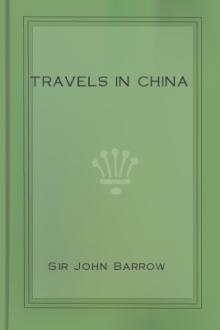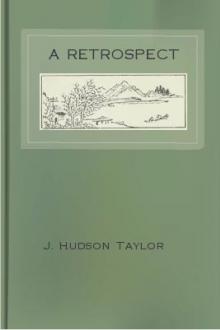Travels in China, Sir John Barrow [phonics readers txt] 📗

- Author: Sir John Barrow
- Performer: -
Book online «Travels in China, Sir John Barrow [phonics readers txt] 📗». Author Sir John Barrow
If the Chinese had, at any period of their history, been acquainted with the art of casting large cannon, and of making use of them in their wars, it is scarcely probable they would ever have lost it. Yet it is very certain the two Jesuits, Schaal and Verbiest, took great pains to instruct them in the method of casting cannon; in which, however, they have not made any progress or improvement. I observed, near one of the gates of Pekin, a few rude, ill-shapen, and disproportionate pieces, lying unmounted on the ground, and these, with some of the same kind on the frontiers of Canton, and a few pieces, apparently twelve pounders, at Hang-tcheu-foo, which had wooden pent-houses erected over each, were the only cannon that we noticed in the whole country. Whether the specimens, exhibited in the annexed plate, which were drawn by the late Captain Parish of the Royal Artillery, be originally of Chinese invention, or borrowed from some other nation, I cannot take upon me to decide; but such are the pieces which are sometimes found, scattered about the gates of some of their cities.
Mr. Bell, who visited China in the suite of the Russian Embassador, near a century ago, remarks, that "towards the western extremity of the Great Wall, he observed some hundreds of old cannon piled up in one of the towers, each composed of three or four pieces of hammered iron, joined and fastened together with hoops of the same metal." It is probable indeed that the Chinese, like the Hindoos, before the time of Schaal and Verbiest, made use of cannon of wrought iron, which were hooped together like those mentioned by Mr. Bell.
Sketches of Chinese Artillery.
References.
2. Iron four Pounder about 8 feet long at Chong san chien
3. A Field Piece about the Calibre and length of our Wall Piece
but of much greater thickness of Metal
4. Half Pounder Field Piece
5. A Platform of Masonry with irregular Pieces about 2 pounders
probably for throwing stones. They are thus placed in the open
Spaces at the Gate Ways at PEKIN and Ton cheu
6. A Stand for Field Pieces at Cou pe keou
Neele sculp. 352 Strand.
Published May 1st. 1804 by Cadell & Davies Strand.
In making their salutes, of which they are not sparing, they invariably employ three small petards, or pistol-barrels rather, which are stuck erect in the ground; and in firing these small pieces the soldiers are so afraid, that they are discharged by a train laid from one to the other. When Captain Parish caused a few rounds to be fired from two field-pieces, which were among the presents for the Emperor, in as quick succession as possible, the Chinese officers very coolly observed, that their own soldiers could do it just as well, and perhaps better. And when Lord Macartney asked the Ex-viceroy of Canton if he would wish to see his guard go through the different evolutions as practised in Europe, he replied with equal indifference, "That they could not possibly be new to him, who had been so much engaged in the wars on the frontiers of Tartary;" though the chances are, that he had never before seen a firelock: with such ridiculous affectation of superiority, and contempt for other nations, does the unconquerable pride of this people inspire them. It seems, indeed, to be laid down as a general principle, never to be caught in the admiration of any thing brought among them by foreigners. Whenever a man of rank came to look at the presents, if observed by any of us, he would carelessly glance his eye over them, and affect as much indifference as if he was in the daily habit of viewing things of the same kind.
A French physician, who travelled in China, says he never saw an alembic or distillatory apparatus in the whole country. The art of distillation, however, is very well known, and in common practice. Their Sau-tchoo, (literally burnt wine), is an ardent spirit distilled from various kinds of grain, but most commonly from rice, of a strong empyreumatic flavour, not unlike the spirit known in Scotland by the name of whiskey. The rice is kept in hot water till the grains are swollen; it is then mixed up with water in which has been dissolved a preparation called pe-ka, consisting of rice-flour, liquorice-root, anniseed, and garlic; this not only hastens fermentation, but is supposed to give it a peculiar flavour. The mixture then undergoes distillation. The Sau-tchoo, thus prepared, may be considered as the basis of the best arrack, which in Java is exclusively the manufacture of Chinese, and is nothing more than a rectification of the above spirit, with the addition of molasses and juice of the cocoa-nut tree. Before distillation the liquor is simply called tchoo, or wine, and in this state is a very insipid and disagreeable beverage. The vine grows extremely well in all the provinces, even as far north as Pekin, but the culture of it seems to meet with little encouragement, and no wine is made from the juice of the grape, except by the missionaries near the capital.
The manufacture of earthen ware, as far as depends upon the preparation of the materials, they have carried to a pitch of perfection not hitherto equalled by any nation, except the Japanese, who are allowed to excel them, not only in this branch, but also in all articles of lacquered and varnished ware, which fetch exorbitant prices even in China. The beauty of their porcelain, in a great degree, depends upon the extreme labour and attention that is paid to the assortment, and the preparation of the different articles employed. These are in general a fine sort of clay called Kao-lin which is a species of Soap-rock, and a granite called Pe-tun-tse, composed chiefly of quartz, the proportion of mica being very small. These materials are ground down and washed with the greatest care; and when the paste has been turned or moulded into forms, each piece is put into a box of clay before it goes into the oven; yet with every precaution, it frequently happens (so much is this art still a work of chance) that a whole oven runs together and becomes a mass of vitrified matter. Neither the Chinese nor the Japanese can boast of giving to the materials much elegance of form. With those inimitable models from the Greek and Roman vases, brought into modern use by the ingenious Mr. Wedgwood, they will not bear a comparison. And nothing can be more rude and ill-designed than the grotesque figures and other objects painted, or rather daubed, on their porcelain, which however are generally the work of the wives and children of the labouring poor. That they can do better we have evident proof; for if a pattern be sent out from England, the artists in Canton will execute it with scrupulous exactness; and their colours are inimitable.
The manufacture of glass was totally unknown among them until the last century when, at the recommendation of the Jesuits, a family was engaged to go from France to Pekin, for the purpose of introducing the art of glass-making into the country. The attempt failed of success, and the concern, at the death of the manager, was broken up. In Canton they melt old broken glass and mold it into new forms; and they have been taught to coat plates of glass with silver, which are partially used as looking-glasses; but their common mirrors are of polished metal, which is apparently a composition of copper and zinc.
The pride, or the policy, of the government affecting to despise any thing new or foreign, and the general want of encouragement to new inventions, however ingenious, have been greatly detrimental to the progress of the arts and manufactures. The people discover no want of genius to conceive, nor of dexterity to execute; and their imitative powers have always been acknowledged to be very great. Of the truth of this remark we had several instances at Yuen-min-yuen. The complicated glass lustres, consisting of several hundred pieces, were taken down, piece by piece, in the course of half an hour, by two Chinese, who had never seen any thing of the kind before, and were put up again by them with equal facility; yet Mr. Parker thought it necessary for our mechanics to attend at his warehouse several times to see them taken down and again put together, in order to be able to manage the business on their arrival in China. A Chinese undertook to cut a slip of glass from a large curved piece, intended to cover the great dome of the planetarium, after our two artificers had broken three similar pieces in attempting to cut them with the help of the diamond. The man performed it in private, nor could he be prevailed on to say in what manner he accomplished it. Being a little jagged along the margin, I suspect it was not cut but fractured, perhaps by passing a heated iron over a line drawn with water, or some other fluid. It is well known that a Chinese in Canton, on being shewn an European watch, undertook, and succeeded, to make one like it, though he had never seen any thing of the kind before, but it was necessary to furnish him with a main spring, which he could not make: and they now fabricate in Canton, as well as in London, and at one third of the expence, all those ingenious pieces of mechanism which at one time were sent to China in such vast quantities from the repositories of Coxe and Merlin. The mind of a Chinese is quick and apprehensive, and





Comments (0)